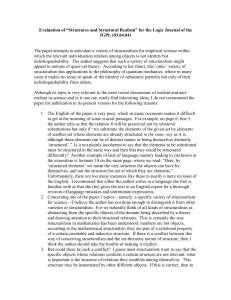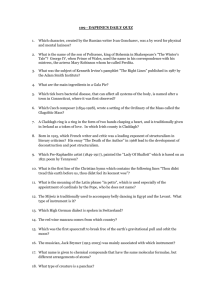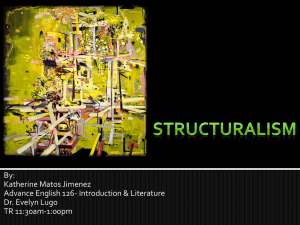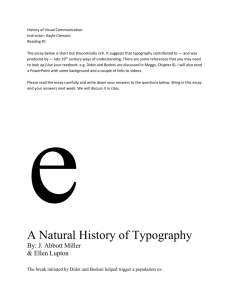Shapiro`s and Hellman`s Structuralism
advertisement
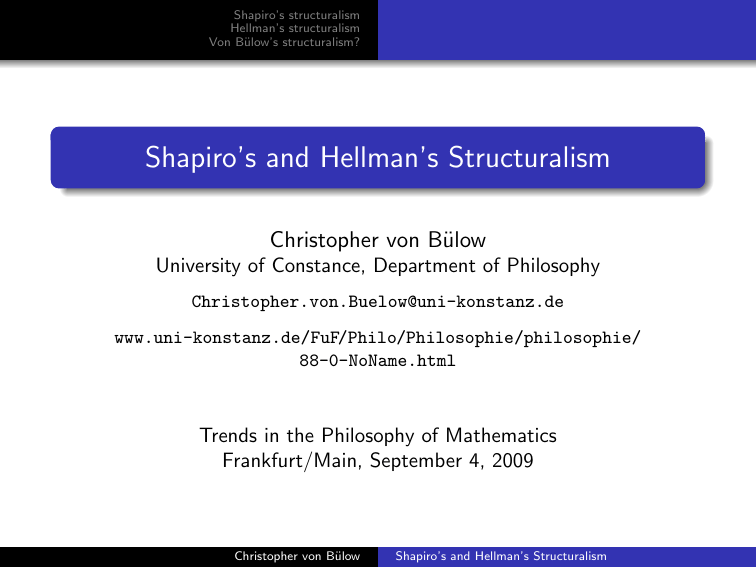
Shapiro’s structuralism
Hellman’s structuralism
Von Bülow’s structuralism?
Shapiro’s and Hellman’s Structuralism
Christopher von Bülow
University of Constance, Department of Philosophy
Christopher.von.Buelow@uni-konstanz.de
www.uni-konstanz.de/FuF/Philo/Philosophie/philosophie/
88-0-NoName.html
Trends in the Philosophy of Mathematics
Frankfurt/Main, September 4, 2009
Christopher von Bülow
Shapiro’s and Hellman’s Structuralism
Shapiro’s structuralism
Hellman’s structuralism
Von Bülow’s structuralism?
(1) Two versions of structuralism
Stewart Shapiro (Philosophy of Mathematics, 1997):
Mathematical objects like the numbers are ‘places in
structures’; structures are universals/ones-over-many:
properties of systems.
Geoffrey Hellman (Mathematics without Numbers, 1989):
There are neither mathematical objects nor structures
(in Shapiro’s sense); mathematical propositions are
implicit generalizations about logically possible systems.
Christopher von Bülow
Shapiro’s and Hellman’s Structuralism
Shapiro’s structuralism
Hellman’s structuralism
Von Bülow’s structuralism?
Contents
1
Shapiro’s structuralism
Systems and structures
Places in structures
Are the office places the mathematical objects?
Mathematical objects are unnecessary
2
Hellman’s structuralism
Generality and triviality
Possibility is unnecessary
3
Von Bülow’s structuralism?
Christopher von Bülow
Shapiro’s and Hellman’s Structuralism
Shapiro’s structuralism
Hellman’s structuralism
Von Bülow’s structuralism?
Systems and structures
Places in structures
Are the office places the mathematical objects?
Mathematical objects are unnecessary
(2) The nat.-number structure: a property of systems
Consider the natural numbers: 0, 1, 2, . . .
Do they exist??? If so, what are they???
One thing is clear: the natural numbers are supposed to be
interrelated by, e.g., the successor relation in such a way
that the Peano axioms are satisfied.
This way of being interrelated by a two-place relation
is a (second-order) property that systems can have,
a one-over-many . . .
. . . or a second-order relation between (1) a collection of objects
and (2) a relation on that collection.
This property of systems is the natural-number structure.
Christopher von Bülow
Shapiro’s and Hellman’s Structuralism
Shapiro’s structuralism
Hellman’s structuralism
Von Bülow’s structuralism?
Systems and structures
Places in structures
Are the office places the mathematical objects?
Mathematical objects are unnecessary
(3) Systems having the natural-number structure
The natural-number system (ℕ, Succ) – if it exists –
has the natural-number structure.
So do, inter alia, certain set-theoretical systems, for example,
{
} {{
}}
the Zermelo numerals : ∅, {∅}, {∅} ,
{∅} , . . .
(where “y is the successor of x” means “y = {x}”)
the finite von Neumann
ordinals : }
{
} {
{
}
∅, {∅}, ∅, {∅} , ∅, {∅}, ∅, {∅} , . . .
(where “y is the successor of x” means “y = x ∪ {x}”)
– assuming that sets exist.
Christopher von Bülow
Shapiro’s and Hellman’s Structuralism
Shapiro’s structuralism
Hellman’s structuralism
Von Bülow’s structuralism?
Systems and structures
Places in structures
Are the office places the mathematical objects?
Mathematical objects are unnecessary
(4) Dubious exemplars, well-understood property
Uncertain:
Are there systems having the natural-number structure???
(systems consisting of physical objects???)
If such systems exist, is there one special, distinguished system
among them that contains the numbers???
(instead of merely objects which can be used as numbers)
But:
We know (reasonably well) what the natural-number structure
itself, as a property of systems, is.
Christopher von Bülow
Shapiro’s and Hellman’s Structuralism
Shapiro’s structuralism
Hellman’s structuralism
Von Bülow’s structuralism?
Systems and structures
Places in structures
Are the office places the mathematical objects?
Mathematical objects are unnecessary
(5) Places in structures
{
}
The
{ set} {∅} ‘does’ in the system of Zermelo numerals what
∅, {∅} does in the system of finite von Neumann ordinals,
or what 2 does in the system of the natural numbers.
They each play the same role in their respective systems.
{
}
The set {∅} ‘is in’ the system of Zermelo numerals
‘where’ 2 is in the system of the natural numbers.
They occupy the same place in their different systems.
We call this place the 2-place in the natural-number structure.
Christopher von Bülow
Shapiro’s and Hellman’s Structuralism
Shapiro’s structuralism
Hellman’s structuralism
Von Bülow’s structuralism?
Systems and structures
Places in structures
Are the office places the mathematical objects?
Mathematical objects are unnecessary
(6) Objects of systems occupy places in a structure
For every system having the natural-number structure,
its 0-object occupies the 0-place in that system.
Each 0-object’s successor occupies the 1-place in the given system.
And so on.
The natural-number structure has countably many places:
the 0-place, the 1-place, the 2-place, . . .
What are places?
Do they exist? Can we consider them as objects?
Christopher von Bülow
Shapiro’s and Hellman’s Structuralism
Shapiro’s structuralism
Hellman’s structuralism
Von Bülow’s structuralism?
Systems and structures
Places in structures
Are the office places the mathematical objects?
Mathematical objects are unnecessary
(7) Indiscernibility of places
In the Euclidean plane, for example,
since all points have the same geometric properties,
every point plays the same role.
So the places in the Euclidean-plane structure, it seems,
are all indiscernible, though distinct.
Is this a problem for Shapiro’s structuralism?
It’s not one I worry about.
Reason: Places in structures are like the ‘places’ of relations.
How is that, and how does it help with indiscernibility?
Christopher von Bülow
Shapiro’s and Hellman’s Structuralism
Shapiro’s structuralism
Hellman’s structuralism
Von Bülow’s structuralism?
Systems and structures
Places in structures
Are the office places the mathematical objects?
Mathematical objects are unnecessary
(8) Structures as 𝜈-place relations
For example,
“x is less than y ”
is a two-place relation; it has an ‘x-place’ and a ‘y -place’.
Now take the natural-number structure: Considered as
a property of whole systems, it is a one-place relation.
Whereas if you consider it as a relation between
(1) a collection of objects and (2) a relation on that collection,
it is a two-place relation.
If, however, you consider the natural-number structure
as a relation between countably many objects and one relation,
then it is an (𝜔+1)-place relation.
The places of the natural-number structure are like
the argument places of such a relation.
Christopher von Bülow
Shapiro’s and Hellman’s Structuralism
Shapiro’s structuralism
Hellman’s structuralism
Von Bülow’s structuralism?
Systems and structures
Places in structures
Are the office places the mathematical objects?
Mathematical objects are unnecessary
(9) Argument places of symmetric relations
If such argument places are sometimes indiscernible,
it is not a problem:
For example, the argument places of the relation
“x is the same age as y ”
(or of any other symmetric relation) aren’t discernible either.1
So what? The task of better understanding argument places
is one we are burdened with independently of mathematics.
1
Yes, in linguistic expressions or other representations of that relation you
have discernible place-holders for argument designations. But the relation itself
and its places aren’t linguistic phenomena.
Christopher von Bülow
Shapiro’s and Hellman’s Structuralism
Shapiro’s structuralism
Hellman’s structuralism
Von Bülow’s structuralism?
Systems and structures
Places in structures
Are the office places the mathematical objects?
Mathematical objects are unnecessary
(10) Are the places the mathematical objects?
I have no scruples about accepting places in structures into an
account of mathematics.
But I don’t believe that they are the mathematical objects.
Up to now, I have talked about places as somewhat like offices
to be occupied, or like roles to be played, by other objects.
Shapiro calls this the places-are-offices perspective.
I suggest that this is a concept of places rather than a perspective
on them: I call places in this sense the office places of a structure.
Question: Are the office places of mathematical structures
the mathematical objects?
Christopher von Bülow
Shapiro’s and Hellman’s Structuralism
Shapiro’s structuralism
Hellman’s structuralism
Von Bülow’s structuralism?
Systems and structures
Places in structures
Are the office places the mathematical objects?
Mathematical objects are unnecessary
(11) What are mathematical objects like?
What are numbers like?
Paul Benacerraf, “What Numbers Could Not Be”
(Philosophical Review, 1965):
If the numbers exist then their mathematical properties
consist in their arithmetical relations to each other:
the number 2 is the successor of 1, the predecessor of 3,
the first prime, etc. – otherwise it wouldn’t be 2.
And their mathematical properties do not include,
e. g., any set-theoretical relations between them:
“Is 2 ∈ 4?” is a bad question, it doesn’t make much sense.2
Moral:
Mathematical objects (if they exist) have a ‘relational essence’.
2
It does make more sense than “Is 2 an element element?” For example,
“If 2 ∈ 4 then 2 ∈ 4∪7” seems somewhat plausible.
Christopher von Bülow
Shapiro’s and Hellman’s Structuralism
Shapiro’s structuralism
Hellman’s structuralism
Von Bülow’s structuralism?
Systems and structures
Places in structures
Are the office places the mathematical objects?
Mathematical objects are unnecessary
(12) Essence places (= mathematical objects)
When we talk about mathematical objects like this –
not considering them as ‘offices’ but rather as objects
in their own right: e.g., “2+2 = 4”, “5 is prime” –
Shapiro considers it as another perspective on places in structures:
the places-are-objects perspective.
I suggest that this is another concept of places. I call places in
this sense relational-essence places, or “essence places” for short.
They are ‘places’ which stand in certain mathematical relations
to each other (which are peculiar to the structure they belong to),
and only in those mathematical relations.
Essence places are the same as mathematical objects
(if they exist).
Christopher von Bülow
Shapiro’s and Hellman’s Structuralism
Shapiro’s structuralism
Hellman’s structuralism
Von Bülow’s structuralism?
Systems and structures
Places in structures
Are the office places the mathematical objects?
Mathematical objects are unnecessary
(13) Office places = essence places?
Shapiro doesn’t distinguish between what I call office places and
essence places. Mostly he just presupposes that they are the same.
One attempt to motivate the identification:
In contrast to this office orientation, there are contexts
in which the places of a given structure are treated
as objects in their own right, at least grammatically.
That is, sometimes items that denote places are bona
fide singular terms. We say that the vice president is
president of the Senate, that the chess bishop moves
on a diagonal, . . .
My perspective . . . presupposes that statements in the
places-are-objects perspective are to be taken literally,
at face value. Bona fide singular terms, like “vice
president,” “shortstop,” and “2,” denote bona fide
objects. (Philosophy of Mathematics, p. 83)
Christopher von Bülow
Shapiro’s and Hellman’s Structuralism
Shapiro’s structuralism
Hellman’s structuralism
Von Bülow’s structuralism?
Systems and structures
Places in structures
Are the office places the mathematical objects?
Mathematical objects are unnecessary
(14) Offices treated as objects – allegedly
Shapiro: In the sentence
“The chess bishop moves on a diagonal”
– when it does not refer to a particular concrete chess piece –
“the chess bishop” denotes a role concrete chess pieces can play.
Analogously, in
“5 is prime”
– when it doesn’t refer to the 5-object of some particular
‘concrete’ system with the natural-number structure
like, e. g., the Zermelo numerals –
“5” would denote an office place in the natural-number structure.
If so, then this office place would indeed have the primeness
property that is characteristic of certain numbers,
i. e., certain relational-essence places.
Thus office places would indeed be essence places.
Christopher von Bülow
Shapiro’s and Hellman’s Structuralism
Shapiro’s structuralism
Hellman’s structuralism
Von Bülow’s structuralism?
Systems and structures
Places in structures
Are the office places the mathematical objects?
Mathematical objects are unnecessary
(15) Hidden generalizations about office occupants
However, this interpretation of so-called ‘places-are-objects’
sentences is inadequate:
It is not the role of bishop in chess that moves on a diagonal;
it is concrete pieces which move.
“The chess bishop moves on a diagonal” is a hidden generalization.
It is not the offices of vice president and president of the Senate
which coincide; it is their occupants.
“The vice president is president of the Senate” is another hidden
generalization.
Analogously, truths like “5 is prime” do not give us reason to think
that it is the 5–office place which is prime.
Christopher von Bülow
Shapiro’s and Hellman’s Structuralism
Shapiro’s structuralism
Hellman’s structuralism
Von Bülow’s structuralism?
Systems and structures
Places in structures
Are the office places the mathematical objects?
Mathematical objects are unnecessary
(16) Offices treated as objects – really
There are actual ‘places-are-objects sentences’:
“The office of president of the USA has a special seal.”
“The 6-place of the natural-number structure
is just as occupiable as the 0-place.”
These sentences do treat offices as objects in their own right.
But the properties they predicate of them are ones fit only
for offices, not for their occupants.
Christopher von Bülow
Shapiro’s and Hellman’s Structuralism
Shapiro’s structuralism
Hellman’s structuralism
Von Bülow’s structuralism?
Systems and structures
Places in structures
Are the office places the mathematical objects?
Mathematical objects are unnecessary
(17) “5 is prime”: ‘numbers-are-objects’ or general
Shapiro’s everyday sentences,
“The vice president is president of the Senate”,
“The chess bishop moves on a diagonal”,
are disguised generalizations.
By contrast, mathematical sentences can be read in two ways:
Either “5 is prime” talks about a number, an essence place.
Then “prime” expresses a property fit for mathematical
objects, which has no obvious connection to office places.
Or “5 is prime” is a generalization about arbitrary occupants
of the 5-place. It treats 5 as an office, but it does not
predicate primeness of it.
Christopher von Bülow
Shapiro’s and Hellman’s Structuralism
Shapiro’s structuralism
Hellman’s structuralism
Von Bülow’s structuralism?
Systems and structures
Places in structures
Are the office places the mathematical objects?
Mathematical objects are unnecessary
(18) Identifying office places and essence places?
So there is no reason to believe that office places are
essence places/mathematical objects.
Can’t we just postulate that they are the same?
No.
For one thing, office places do not have what it takes
to be essence places:
Christopher von Bülow
Shapiro’s and Hellman’s Structuralism
Shapiro’s structuralism
Hellman’s structuralism
Von Bülow’s structuralism?
Systems and structures
Places in structures
Are the office places the mathematical objects?
Mathematical objects are unnecessary
(19) Office places are not essence places
On the numbers, there is one special successor relation:
the successor relation.
On the office places of the natural-number structure, there is
no such distinguished, privileged successor relation.
The ‘canonical’ successor relation on the office places
is merely particularly easy to specify :
Office place q is a place-successor of office place p iff
in any system S with the natural-number structure,
q’s occupant is the S-successor of p’s occupant.
Thus you get: 0-place ↷ 1-place ↷ 2-place ↷ 3-place ↷ . . .
This relation is only pragmatically, not metaphysically, special:
1-place ↷ 0-place ↷ 3-place ↷ 2-place ↷ . . . works just as well.
Christopher von Bülow
Shapiro’s and Hellman’s Structuralism
Shapiro’s structuralism
Hellman’s structuralism
Von Bülow’s structuralism?
Systems and structures
Places in structures
Are the office places the mathematical objects?
Mathematical objects are unnecessary
(20) Essence places are not office places
Symmetrically, the numbers/essence places do not have
what it takes to be the number–office places:
Office places are special in being occupiable by arbitrary objects.
The way for a system’s objects to occupy the numbers
consists in there being an isomorphism from that system
to the system of the numbers.
‘Occupying’ the number 0 means being mapped onto 0
by that isomorphism.
If that were all it takes to be an office place in the ℕ-structure,
then any system having the ℕ-structure could do the job just as well.
So the numbers/essence places are not especially good candidates
for being the ℕ-structure’s office places.
Christopher von Bülow
Shapiro’s and Hellman’s Structuralism
Shapiro’s structuralism
Hellman’s structuralism
Von Bülow’s structuralism?
Systems and structures
Places in structures
Are the office places the mathematical objects?
Mathematical objects are unnecessary
(21) Mathematical objects: by stipulation only
The office places and the essence places of a structure
do not seem to be the same; the office places of structures
are not plausible candidates for the corresponding essence places,
the mathematical objects.
So Shapiro’s structuralism leaves mathematical objects
as mysterious as before:
If we want to believe in them we have to stipulate them,
like in traditional platonism.
Christopher von Bülow
Shapiro’s and Hellman’s Structuralism
Shapiro’s structuralism
Hellman’s structuralism
Von Bülow’s structuralism?
Systems and structures
Places in structures
Are the office places the mathematical objects?
Mathematical objects are unnecessary
(22) Are mathematical objects needed for semantics?
Do we really need mathematical objects?
Paul Benacerraf, “Mathematical Truth” (Journal of Philosophy,
1973):
We would like to have a Tarski semantics
for mathematical discourse, and for that we need
mathematical objects as denotations of singular terms
like “2”.
But Tarski semantics is just a model of semantics,
not a satisfying account of semantics.
Christopher von Bülow
Shapiro’s and Hellman’s Structuralism
Shapiro’s structuralism
Hellman’s structuralism
Von Bülow’s structuralism?
Systems and structures
Places in structures
Are the office places the mathematical objects?
Mathematical objects are unnecessary
(23) The numbers vs. . . .
Furthermore realism in ontology does not give a very faithful
account of how mathematical discourse acquires its content:
How do we find things out about the numbers?
We talk as if we had one particular system of objects in our hands,
about which we know certain things, e. g., the Peano axioms.
Certain questions we just don’t ask:
“What color does 5 have?”
“Does 5 have any elements?”
Christopher von Bülow
Shapiro’s and Hellman’s Structuralism
Shapiro’s structuralism
Hellman’s structuralism
Von Bülow’s structuralism?
Systems and structures
Places in structures
Are the office places the mathematical objects?
Mathematical objects are unnecessary
(24) . . . vs. a group’s elements
How do we find things out about, say, groups?
We say,
“let G be a group, let ∘ be its multiplication,
and let e be its unit element”,
and then we go on talking as if we had one particular system
of objects in our hands: the group G, about which we know
certain things, e.g., the group axioms.
Certain questions we just don’t ask:
“What color is the unit element?”
“Do any of the objects of G have elements?”
“How many objects are there in G ?”
Christopher von Bülow
Shapiro’s and Hellman’s Structuralism
Shapiro’s structuralism
Hellman’s structuralism
Von Bülow’s structuralism?
Systems and structures
Places in structures
Are the office places the mathematical objects?
Mathematical objects are unnecessary
(25) No relevant difference in practice
In the case of ‘the group G ’, nobody would conclude that
after saying
“Let G be a group”,
we are indeed talking about one particular system:
“the arbitrary group” perhaps, whose objects have only
those properties which follow from the group axioms.
What we are doing is, proving theorems about
all groups whatsoever.
But there is no relevant difference between the cases
of group theory and arithmetic.
This indicates that arithmetic, too, is really about
all systems whatsoever which have the right structure.
Christopher von Bülow
Shapiro’s and Hellman’s Structuralism
Shapiro’s structuralism
Hellman’s structuralism
Von Bülow’s structuralism?
Generality and triviality
Possibility is unnecessary
(26) Another semantics of mathematical discourse?
If there are no numbers, if mathematics is actually general
where it seems to be about particular objects,
then what is the meaning of mathematical propositions
like “2+2 = 4”?
One structuralist answer comes from Geoffrey Hellman:
modal-structuralism.
Christopher von Bülow
Shapiro’s and Hellman’s Structuralism
Shapiro’s structuralism
Hellman’s structuralism
Von Bülow’s structuralism?
Generality and triviality
Possibility is unnecessary
(27) “∀”: the danger of triviality
If arithmetic isn’t about ‘the numbers’ but rather about
arbitrary systems having the natural-number structure,
then, it seems, what “2+2 = 4” really means is
“∀ systems S with the ℕ-structure:
2S +S 2S = 4S .”
But then along comes a philosopher and says:
“ What if there are no systems that have the ℕ-structure?
Then ‘ ∀ ℕ-systems S: 2S +S 2S = 4S ’
would be trivially true,
just like ‘∀ ℕ-systems S: 2S +S 2S = 5S ’ !”
Christopher von Bülow
Shapiro’s and Hellman’s Structuralism
Shapiro’s structuralism
Hellman’s structuralism
Von Bülow’s structuralism?
Generality and triviality
Possibility is unnecessary
(28) “□ ∀”: triviality vanquished (?)
Hellman’s solution:
Arithmetic isn’t just about all ℕ-systems which actually exist,
but rather about whichever ℕ-systems might possibly exist.
So, what “2+2 = 4” really means is
“□ ∀ ℕ-systems S: 2S +S 2S = 4S .”
Since it seems possible that there be infinitely many objects –
“♢ ∃S : S is an ℕ-system”
– this explication of “2+2 = 4” is not in danger of being trivial.
You may, however, get an analogous problem if you apply this
method to set theory, at least if you want your systems to consist
of physical objects:
Is it really logically possible that there be as many physical objects
as there are sets?
Christopher von Bülow
Shapiro’s and Hellman’s Structuralism
Shapiro’s structuralism
Hellman’s structuralism
Von Bülow’s structuralism?
Generality and triviality
Possibility is unnecessary
(29) “♢∃”: asserted or presupposed?
What is it I don’t like about this proposal?
Look at the ‘categorical component’ of arithmetic:
the assertion that systems with the ℕ-structure
are logically possible:
♢ ∃S : S is an ℕ-system.
Mathematicians usually don’t assert things like that;
rather, they tacitly presuppose them.
Is “♢ ∃ ℕ-system” really part of the content of arithmetic?
I think it is rather like a working hypothesis. Someone who
believes this hypothesis false shouldn’t bother doing arithmetic,
at least not for its own sake, because it would be futile.
Christopher von Bülow
Shapiro’s and Hellman’s Structuralism
Shapiro’s structuralism
Hellman’s structuralism
Von Bülow’s structuralism?
Generality and triviality
Possibility is unnecessary
(30) Three kinds of premisses for proofs
The possibility presupposition isn’t essential, however:
Consider three kinds of mathematical proof:
(a) The proof starts with
“Let S be a system with structure so-and-so”,
where one is certain that systems like these (might) exist
(e. g., finite systems or ℕ-systems).
(b) The proof starts with
“Suppose conjecture so-and-so is true”,
where one is uncertain whether so-and-so is true.
(c) The proof starts with
“Suppose so-and-so were the case”,
where one is more or less certain that so-and-so is
logically false.
Christopher von Bülow
Shapiro’s and Hellman’s Structuralism
Shapiro’s structuralism
Hellman’s structuralism
Von Bülow’s structuralism?
Generality and triviality
Possibility is unnecessary
(31) In all cases: substantial results
All three of these cases are ubiquitous and deliver results
with real mathematical content:
In case (a) (certain truth) one obtains a categorical assertion:
“In systems like that, such-and-such is the case.”
In case (b) (uncertain truth) one obtains a conditional:
“If conjecture so-and-so is true then such-and-such holds.”
Case (c) (certain falsehood) arises, e. g.,
in proofs of P by reductio ad absurdum of ¬P,
or in proofs of P → Q by reductio ad absurdum of P ∧¬Q.
Christopher von Bülow
Shapiro’s and Hellman’s Structuralism
Shapiro’s structuralism
Hellman’s structuralism
Von Bülow’s structuralism?
Generality and triviality
Possibility is unnecessary
(32) Different kinds of content?
In all these three kinds of proof, the same thing goes on,
epistemically:
You ‘assume’ P – never mind whether P is logically possible –
and derive consequences.
Assuming in this manner the impossible works just the same way
as assuming the possible or starting from a virtual certainty.
For Hellman, however, different things are going on in case (a)
from cases (b) and (c):
In case (a), where you talk about a kind of system you believe in,
you start by asserting,
“There might be systems like this!”
By contrast, in cases (b) and (c), you don’t start like that.
Christopher von Bülow
Shapiro’s and Hellman’s Structuralism
Shapiro’s structuralism
Hellman’s structuralism
Von Bülow’s structuralism?
Generality and triviality
Possibility is unnecessary
(33) Modal-structuralism is inadequate w. r. t. practice
But cases (a)–(c) are all analogous with respect to mathematical
practice.
For me, this implies that the sorts of content these kinds of proof
deliver are the same.
Since Hellman’s characterization treats them completely
differently, it must be inadequate.
Mathematical content comprises more than what is logically
possible (e.g., “If 2+2 = 5 then (2+2)3 = 53 ”).
Christopher von Bülow
Shapiro’s and Hellman’s Structuralism
Shapiro’s structuralism
Hellman’s structuralism
Von Bülow’s structuralism?
(34) Maths as the science of conceivable structure
What is my constructive counterproposal?
I haven’t got more than very rudimentary and vague suggestions
yet:
Mathematics is nowhere about particular systems,
like ‘the numbers’ or ‘the Euclidean plane’.
Perhaps it is about particular structures or types of structure,
about particular ways systems might conceivably be
(where not everything that’s ‘conceivable’ is also logically possible).
Christopher von Bülow
Shapiro’s and Hellman’s Structuralism
Shapiro’s structuralism
Hellman’s structuralism
Von Bülow’s structuralism?
(35) Maths, the universe and everything
Mathematics is so general that there is no circumscribed realm
of systems or things it is about.3
(That’s a point Hellman often makes, rightly.)
There is not even a however-vaguely-circumscribed
spectrum of realms of systems mathematics is about,
e. g., the spectrum of the logically possible, as in Hellman’s account:
Whenever you circumscribe such a ‘realm’ or ‘spectrum of realms’,
mathematics will transcend it.
E. g., Hellman’s prohibition of quantifying over all possible systems,
or of functions and relations between different possible ‘universes’,
will not forever stop mathematicians.
3
Though probably the real problem lies in attempting to circumscribe,
or in supposing as circumscribed, ‘everything there is’.
Christopher von Bülow
Shapiro’s and Hellman’s Structuralism
Shapiro’s structuralism
Hellman’s structuralism
Von Bülow’s structuralism?
(36) Mathematical content
Perhaps mathematical theorems are not propositions
with a well-defined, exhaustible content,
but rather tools with no pre-determined domain of applicability.
They are applicable to whatever someone might specify some day.
Perhaps mathematics is not about arbitrary conceivable systems
but about arbitrary descriptions or representations
of (structural) kinds of systems.
Some of these descriptions are of impossible systems,
but you can still reason mathematically about
whatever coherent parts those descriptions have.
Christopher von Bülow
Shapiro’s and Hellman’s Structuralism
Shapiro’s structuralism
Hellman’s structuralism
Von Bülow’s structuralism?
(37) How to philosophize about mathematics
How to make this precise? How to formalize it?
A formalism that explicates a philosophy of mathematics
may be a nice model, but it is still just more mathematics;
and you can’t fully understand mathematics just by doing
more mathematics.
Instead, look at how physical agents – machines with goals –
can arrive at, and apply, mathematical knowledge
(or mathematical information, or capabilities).
Christopher von Bülow
Shapiro’s and Hellman’s Structuralism

